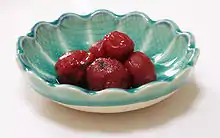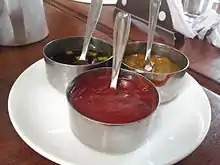Pickled fruit
Pickled fruit refers to fruit that has been pickled.[1] Pickling is the process of food preservation by either anaerobic fermentation in brine or immersion in vinegar. Many types of fruit are pickled.[1] Some examples include peaches, apples, crab apple, pears, plums, grapes, currant, tomato and olives.[1][2] Vinegar may also be prepared from fruit,[2] such as apple cider vinegar.
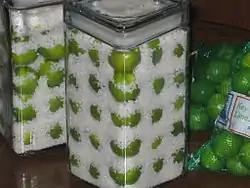
For thousands of years in many parts of the world, pickles have been used as the main method to preserve fruits and other foods. There is evidence that thousands of years ago in Mesopotamia, Egypt, Greece, Rome and China people pickled different foods for preservation. Mayan culture in America used tobacco to conserve food, specifically to make pickled peppers. In ancient times the different cultures used salt that was found naturally and water to make the brine, which they used to pickle foods that cannot be eaten naturally, such as olives and some grains.[3]
Peaches
.jpg.webp)
Pickled peaches may be prepared from medium-sized, non-melting clingstone peaches that are small-seeded.[1] In the United States prior to around 1960, some were prepared from small, unripe freestone peaches.[1] They may be prepared with sugar, cinnamon, cloves and allspice to add flavor. Pickled peaches may be used to accompany meats and in salads,[4] and also have other uses.
Pears
Pickled pears may be prepared with sugar, cinnamon, cloves and allspice to add flavor, and may be referred to as spiced pears.[1] They may be prepared from underripe pears.[5] Pickled pears may be used to accompany dishes
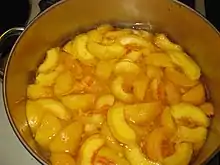
such as roasts and salads,[6] among others.
Grapes
To pickle grapes it is necessary to use white wine vinegar, water, kosher salt, sugar, cloves garlic, rosemary and dried chili flakes. Garlic, chili flakes and some other species make grapes a unique flavor.[7]
Cantaloupe
The cantaloupe is a summer season fruit, which can be pickled and refrigerated to be able to eat it during the rest of the year. The cantaloupe can be pickled using champagne vinegar, hot water, granulated sugar, ice, mustard seed, celery seed, Aleppo pepper and cinnamon stick.[7]
List of pickled fruits
.jpg.webp)
- Apple [8]
- Apricot [8]
- Barberry [8]
- Blackberry [8]
- Blueberry [10]
- Caper [11]
- Cherry [8]
- Citrus peel [10]
- Currant [1]
- Dates [8]
- Damson [8]
- Fig [10]
- Grape [1]
- Mango pickle [2]
- Nata de coco – fermented coconut juice[2]
- Nata de pina – fermented pineapple juice[2]
- Olives [1][12]
- Orange [4]
- Peach [1]
- Pear [1]
- Peppadew
- Pickled lime [2]
- Pickled pepper
- Plum [1]
- Preserved lemon [2]
- Prunes [13]
- Strawberry [10]
- Tomato [1]
- Watermelon may be pickled, as well as watermelon rind.[14][15][16]
- Pickled fruits
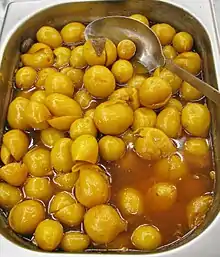
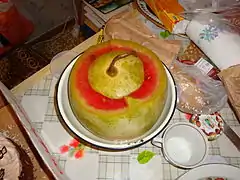 Pickled watermelon.
Pickled watermelon.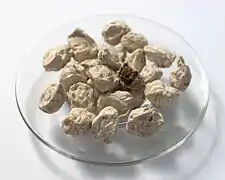 Buai khem is Thai for "salted (Chinese) plums". They are prepared from Prunus mume (also known as "Chinese Plum" or "Japanese Apricot"), and are pickled, dried, and salted.
Buai khem is Thai for "salted (Chinese) plums". They are prepared from Prunus mume (also known as "Chinese Plum" or "Japanese Apricot"), and are pickled, dried, and salted.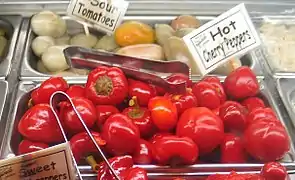 Pickled pimientos
Pickled pimientos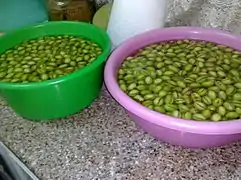 Olives being pickled
Olives being pickled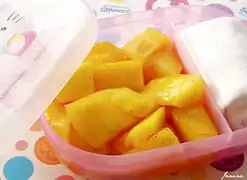
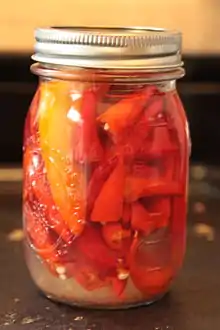 Jarred pickled peppers
Jarred pickled peppers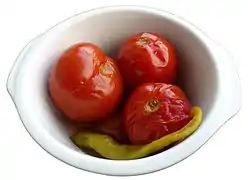 Pickled tomatoes
Pickled tomatoes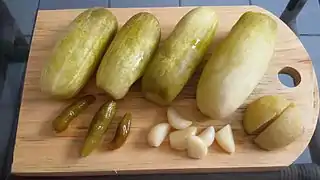 Pickled apple along with other vegetables.
Pickled apple along with other vegetables.
By country
In Malaysia, some fruits are pickled when they are unripe, such as belimbing, kedondong, chermai,[17] lime, pineapple, papaya, mango and nutmeg.[18]

In Mexico the word "pickle" means "escabechar or encurtir" this term is used when food is pickled by vinegar. When salt is the main ingredient for pickling then it is called "escabeche or salmuera."[19]
The word vinegar is of French origin (Vin - Aigre) and means in Spanish "vino-agrio" and in English "wine-sour". In its origins the vinegar was the result of the fermentation of the wine which was sour. In Mexico, vinegar is obtained in large part from the fermentation of some fruits, such as pineapple and apple, this type of vinegar is very common to find it naturally made at home, people use it to pickle fruits and vegetables in the home. The pickle is very popular in Mexico with different peppers the peppers being one of the main products both in the pickle industry and in a homemade way. Some states in Mexico such as Oaxaca and Puebla use pickled homemade vinegar made from fermented pineapple or sour brine to pickle fruits such as mangoes, membrillos and some cactus, then be used as ingredients in traditional cooking.[19]
See also
- Chutney – Condiments associated with South Asian cuisine made from a highly variable mixture of spices, vegetables, or fruit
- List of condiments – Wikipedia list article
- List of fruit dishes – Wikipedia list article
- List of Indian pickles – Wikipedia list article
- List of pickled foods – List of links to Wikipedia articles on pickled foods
- Peter Piper – Nursery rhyme
- Pickles in India and Pakistan
References
| Wikimedia Commons has media related to Pickled fruit. |
- Woodroof, J.G.; Luh, B.S. (1986). Commercial Fruit Processing. Springer Netherlands. pp. 521–. ISBN 978-94-011-7385-8.
- Battcock, M.; Azam-Ali, Sue (1998). Fermented Fruits and Vegetables: A Global Perspective. FAO agricultural services bulletin. Food and Agriculture Organization of the United Nations. p. 14. ISBN 978-92-5-104226-7.
- Derven, Daphne (2003). Encyclopedia of Food and Culture Vol. 3. Charles Scribners Sons. p. 152.
- Carrolata, K. (2012). Pickled: From Curing Lemons to Fermenting Cabbage, the Gourmand's Ultimate Guide to the World of Pickling. Adams Media. pp. 86–87. ISBN 978-1-4405-3873-5.
- Chesman, A. (2012). The Pickled Pantry: From Apples to Zucchini, 150 Recipes for Pickles, Relishes, Chutneys & More. Storey Publishing, LLC. p. 109. ISBN 978-1-60342-890-3.
- Hobson, J.; Watts, P. (2012). Making Traditional and Modern Chutneys, Pickles and Relishes: A Comprehensive Guide. Crowood Press, Limited. p. 119. ISBN 978-1-84797-502-7.
- Stabiner, Karen (August 3, 2016). "Refrigerator Pickles: Summer Fruit, All Sealed Up". The Wall Street Journal. Retrieved October 6, 2019.
- Home Pickling. Culinary arts. Taylor & Francis. 2014. ISBN 978-1-317-84643-7.
- Tsuji, S. (2007). Japanese Cooking: A Simple Art. Cookery, Food and Drink Series. Kodansha International Limited. p. 317. ISBN 978-4-7700-3049-8.
- McCarthy, L. (2012). Jam On: The Craft of Canning Fruit. Penguin Publishing Group. pp. 163–. ISBN 978-1-101-57516-1.
- Carrolata, K. (2012). Pickled: From curing lemons to fermenting cabbage, the gourmand's ultimate guide to the world of pickling. F+W Media. p. 41. ISBN 978-1-4405-4023-3.
- California Fruit News. Howard C. Rowley. 1921. p. 3.
- Grigson, J.; Skargon, Y.; Hill, J.; Dickerman, S. (2007). Jane Grigson's Fruit Book. At table series. University of Nebraska Press. p. 449. ISBN 978-0-8032-5993-5.
- Ziedrich, L.; Williams, C. (2009). The Joy of Pickling: 250 Flavor-packed Recipes for Vegetables and More from Garden Or Market. Harvard Common Press. p. 287. ISBN 978-1-55832-375-9.
- Andrea, A.L. (1918). Home Canning, Drying and Preserving. Doubleday, Page. p. 107.
- White, A.; Varney, J. (2012). Philadelphia Chef's Table: Extraordinary Recipes from the City of Brotherly Love. Chef's Table. Lyons Press. p. 147. ISBN 978-0-7627-8944-3.
- Janick, J.; Paull, R.E. (2008). The Encyclopedia of Fruit and Nuts. CABI Publishing Series. CABI North American Office. p. 373. ISBN 978-0-85199-638-7.
- Steinkraus, K. (1995). Handbook of Indigenous Fermented Foods, Second Edition, Revised and Expanded. Food Science and Technology. Taylor & Francis. p. 139. ISBN 978-0-8247-9352-4.
- Hursh Graber, Karen (October 1, 2006). "Preserving the Fall harvest:Mexican pickles and vinaigrettes". Mexconnect. Retrieved September 29, 2019.
